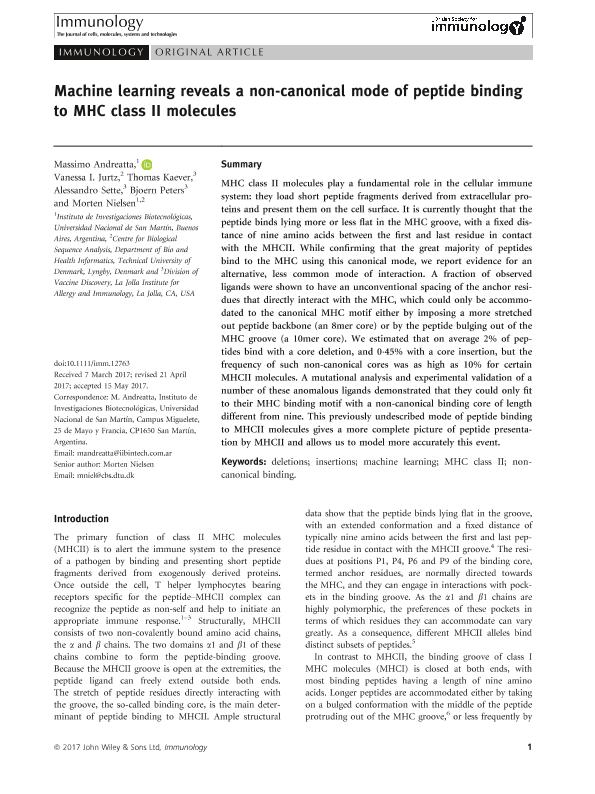Artículo
Machine learning reveals a non‐canonical mode of peptide binding to MHC class II molecules
Andreatta, Massimo ; Jurtz, Vanessa I.; Kaever, Thomas; Sette, Alessandro; Peters, Bjoern; Nielsen, Morten
; Jurtz, Vanessa I.; Kaever, Thomas; Sette, Alessandro; Peters, Bjoern; Nielsen, Morten
 ; Jurtz, Vanessa I.; Kaever, Thomas; Sette, Alessandro; Peters, Bjoern; Nielsen, Morten
; Jurtz, Vanessa I.; Kaever, Thomas; Sette, Alessandro; Peters, Bjoern; Nielsen, Morten
Fecha de publicación:
10/2017
Editorial:
Wiley Blackwell Publishing, Inc
Revista:
Immunology
ISSN:
0019-2805
Idioma:
Inglés
Tipo de recurso:
Artículo publicado
Clasificación temática:
Resumen
MHC class II molecules play a fundamental role in the cellular immune system: they load short peptide fragments derived from extracellular proteins and present them on the cell surface. It is currently thought that the peptide binds lying more or less flat in the MHC groove, with a fixed distance of nine amino acids between the first and last residue in contact with the MHCII. While confirming that the great majority of peptides bind to the MHC using this canonical mode, we report evidence for an alternative, less common mode of interaction. A fraction of observed ligands were shown to have an unconventional spacing of the anchor residues that directly interact with the MHC, which could only be accommodated to the canonical MHC motif either by imposing a more stretched out peptide backbone (an 8mer core) or by the peptide bulging out of the MHC groove (a 10mer core). We estimated that on average 2% of peptides bind with a core deletion, and 0·45% with a core insertion, but the frequency of such non‐canonical cores was as high as 10% for certain MHCII molecules. A mutational analysis and experimental validation of a number of these anomalous ligands demonstrated that they could only fit to their MHC binding motif with a non‐canonical binding core of length different from nine. This previously undescribed mode of peptide binding to MHCII molecules gives a more complete picture of peptide presentation by MHCII and allows us to model more accurately this event.
Palabras clave:
Deletions
,
Insertions
,
Machine Learning
,
Mhc Class Ii
,
Non-Canonical Binding
Archivos asociados
Licencia
Identificadores
Colecciones
Articulos(IIB-INTECH)
Articulos de INST.DE INVEST.BIOTECNOLOGICAS - INSTITUTO TECNOLOGICO CHASCOMUS
Articulos de INST.DE INVEST.BIOTECNOLOGICAS - INSTITUTO TECNOLOGICO CHASCOMUS
Citación
Andreatta, Massimo; Jurtz, Vanessa I.; Kaever, Thomas; Sette, Alessandro; Peters, Bjoern; et al.; Machine learning reveals a non‐canonical mode of peptide binding to MHC class II molecules; Wiley Blackwell Publishing, Inc; Immunology; 152; 2; 10-2017; 255-264
Compartir
Altmétricas



